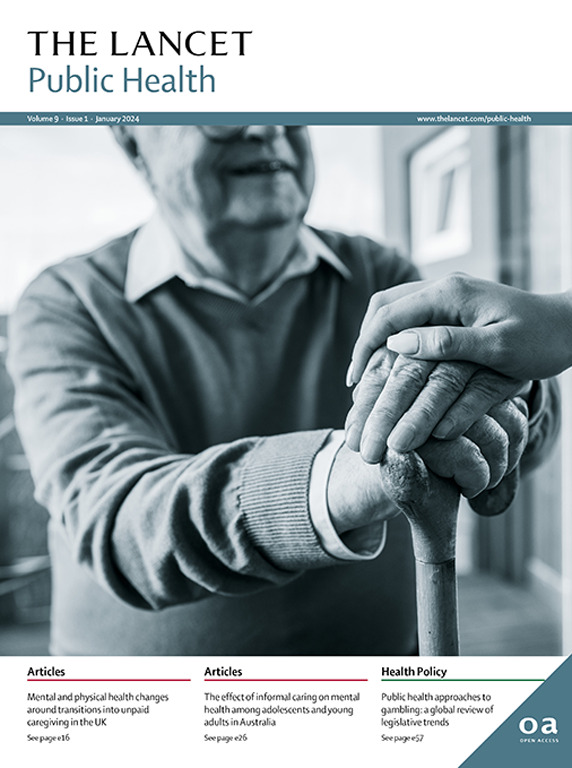预测 2022 至 2050 年吸烟率情景对生命损失年数和预期寿命的影响:2021 年全球疾病负担研究的系统分析
IF 25.4
1区 医学
Q1 PUBLIC, ENVIRONMENTAL & OCCUPATIONAL HEALTH
引用次数: 0
摘要
背景吸烟是导致全球死亡的主要行为风险因素,从 1990 年到 2021 年,吸烟造成的死亡人数超过 1.75 亿,生命损失年数近 430 亿年。近年来,许多国家的吸烟率下降速度放缓,虽然最近提出了实现无烟世代的战略,但迄今为止尚未实施。评估如果目前的吸烟率趋势持续下去会出现什么情况,以及如果吸烟率进一步下降会出现什么情况,对于宣传潜在的吸烟政策效果非常重要。方法在这项分析中,我们使用了卫生计量与评估研究所的未来健康情景平台,预测了三种吸烟率情景对2050年前全因和特定病因的YLL以及出生时预期寿命的影响。使用全球疾病负担研究 2021 年参考寿命表和每种情景下的特定病因死亡率预测值,计算了每种情景下的 YLLs。参考情景预测了如果过去的吸烟率和其他风险因素趋势持续下去可能会发生的情况,2023 年消除烟草烟雾(Elimination-2023)情景量化了假设从 2023 年起吸烟率为零的最大潜在未来健康益处,而 2050 年消除烟草烟雾(Elimination-2050)情景为考虑将吸烟率稳步降至 5%的国家提供了估计值。这些情景共同强调了如果各国采取果断行动消除吸烟,到 2050 年可实现的健康惠益规模。估计值的 95% 不确定区间 (UI) 是基于通过多阶段计算框架得出的第 2-5 百分位数和第 97-5 百分位数。研究结果据估计,2022 年全球男性年龄标准化吸烟率为 28-5%(95% UI 为 27-9-29-1),女性为 5-96%(5-76-6-21)。在参考情景下,从2022年到2050年,男性吸烟率下降25-9%(25-2-26-6),女性吸烟率下降30-0%(26-1-32-1)。在这一情景下,我们预测在此期间男性吸烟率将累计下降 290 亿-30 亿(95% UI 26-8-32-4),女性吸烟率将累计下降 220 亿(20-1-24-6)。在此情景下,出生时预期寿命将从 2022 年的 73-6 岁(95% UI 72-8-74-4)增加到 2050 年的 78-3 岁(75-9-80-3)。在 "消除-2023 年 "情景下,与参考情景相比,我们预测到 2050 年累计年均寿命将减少 2040 亿(95% UI 1-90-2-21),男性出生时预期寿命将增加到 77-6 岁(95% UI 75-1-79-6),女性出生时预期寿命将增加到 81-0 岁(78-5-83-1)。根据我们的 "消除-2050 年 "方案,我们预测男性和女性将分别避免 7.35 亿(6.75-8.08 亿)和 1.41 亿(1.31-154 亿)个累积年死亡率。2050 年男性预期寿命将增加到 77-1 岁(95% UI 74-6-79-0),女性预期寿命将增加到 80-8 岁(78-3-82-9)。此外,通过加快消除吸烟的步伐,可以避免大量的吸烟导致的负担。实施新的烟草控制政策对于避免未来几十年额外的吸烟导致的负担以及确保过去三十年取得的成果不会丧失至关重要。本文章由计算机程序翻译,如有差异,请以英文原文为准。
Forecasting the effects of smoking prevalence scenarios on years of life lost and life expectancy from 2022 to 2050: a systematic analysis for the Global Burden of Disease Study 2021
Background
Smoking is the leading behavioural risk factor for mortality globally, accounting for more than 175 million deaths and nearly 4·30 billion years of life lost (YLLs) from 1990 to 2021. The pace of decline in smoking prevalence has slowed in recent years for many countries, and although strategies have recently been proposed to achieve tobacco-free generations, none have been implemented to date. Assessing what could happen if current trends in smoking prevalence persist, and what could happen if additional smoking prevalence reductions occur, is important for communicating the effect of potential smoking policies.Methods
In this analysis, we use the Institute for Health Metrics and Evaluation's Future Health Scenarios platform to forecast the effects of three smoking prevalence scenarios on all-cause and cause-specific YLLs and life expectancy at birth until 2050. YLLs were computed for each scenario using the Global Burden of Disease Study 2021 reference life table and forecasts of cause-specific mortality under each scenario. The reference scenario forecasts what could occur if past smoking prevalence and other risk factor trends continue, the Tobacco Smoking Elimination as of 2023 (Elimination-2023) scenario quantifies the maximum potential future health benefits from assuming zero percent smoking prevalence from 2023 onwards, whereas the Tobacco Smoking Elimination by 2050 (Elimination-2050) scenario provides estimates for countries considering policies to steadily reduce smoking prevalence to 5%. Together, these scenarios underscore the magnitude of health benefits that could be reached by 2050 if countries take decisive action to eliminate smoking. The 95% uncertainty interval (UI) of estimates is based on the 2·5th and 97·5th percentile of draws that were carried through the multistage computational framework.Findings
Global age-standardised smoking prevalence was estimated to be 28·5% (95% UI 27·9–29·1) among males and 5·96% (5·76–6·21) among females in 2022. In the reference scenario, smoking prevalence declined by 25·9% (25·2–26·6) among males, and 30·0% (26·1–32·1) among females from 2022 to 2050. Under this scenario, we forecast a cumulative 29·3 billion (95% UI 26·8–32·4) overall YLLs among males and 22·2 billion (20·1–24·6) YLLs among females over this period. Life expectancy at birth under this scenario would increase from 73·6 years (95% UI 72·8–74·4) in 2022 to 78·3 years (75·9–80·3) in 2050. Under our Elimination-2023 scenario, we forecast 2·04 billion (95% UI 1·90–2·21) fewer cumulative YLLs by 2050 compared with the reference scenario, and life expectancy at birth would increase to 77·6 years (95% UI 75·1–79·6) among males and 81·0 years (78·5–83·1) among females. Under our Elimination-2050 scenario, we forecast 735 million (675–808) and 141 million (131–154) cumulative YLLs would be avoided among males and females, respectively. Life expectancy in 2050 would increase to 77·1 years (95% UI 74·6–79·0) among males and 80·8 years (78·3–82·9) among females.Interpretation
Existing tobacco policies must be maintained if smoking prevalence is to continue to decline as forecast by the reference scenario. In addition, substantial smoking-attributable burden can be avoided by accelerating the pace of smoking elimination. Implementation of new tobacco control policies are crucial in avoiding additional smoking-attributable burden in the coming decades and to ensure that the gains won over the past three decades are not lost.Funding
Bloomberg Philanthropies and the Bill & Melinda Gates Foundation.求助全文
通过发布文献求助,成功后即可免费获取论文全文。
去求助
来源期刊

Lancet Public Health
Medicine-Public Health, Environmental and Occupational Health
CiteScore
55.60
自引率
0.80%
发文量
305
审稿时长
8 weeks
期刊介绍:
The Lancet Public Health is committed to tackling the most pressing issues across all aspects of public health. We have a strong commitment to using science to improve health equity and social justice. In line with the values and vision of The Lancet, we take a broad and inclusive approach to public health and are interested in interdisciplinary research.
We publish a range of content types that can advance public health policies and outcomes. These include Articles, Review, Comment, and Correspondence. Learn more about the types of papers we publish.
 求助内容:
求助内容: 应助结果提醒方式:
应助结果提醒方式:


